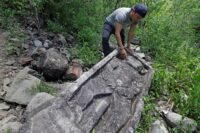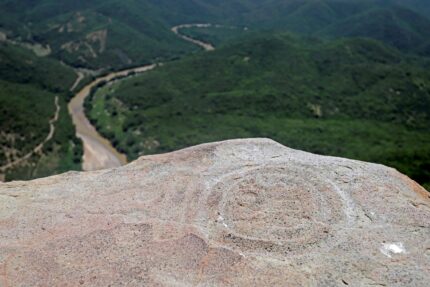 Residents of the village of Santa Cruz Huehuepiaxtla, Puebla, southeastern Mexico, have discovered two Prehispanic stele and dozens of glyphs carved on stone. They were in a remote location at the summit of the Cerro de la Peña mountain.
Residents of the village of Santa Cruz Huehuepiaxtla, Puebla, southeastern Mexico, have discovered two Prehispanic stele and dozens of glyphs carved on stone. They were in a remote location at the summit of the Cerro de la Peña mountain.
Archaeologists had to hike a rocky trail, much of it at a steep incline, for two and a half hours to reach the find site 2800 feet above sea level. They documented the two stele and 87 glyphs carved into the hilltop rock.
Believed to have been carved by Zapotec or Teotihuacán people, the archaeological relics have been dated to about 500 AD. Archaeologists believe that the site at which they were found was dedicated to a god of the underworld[, Mictlantecuhtli].
The best preserved stelae shows a person with horns and claws dressed in a loincloth. There are also stones engraved with images of an iguana, a bird that appears to be an eagle and a dios murciélago, or bat god, in the form of a woman.
The survey at the summit has revealed evidence of a ceremonial complex with seven pyramids and a ball court. The inscriptions on the stone slopes of the hilltop are written in the logographic ñuiñe script of the Mixteca Baja area in south-central Mexico. The Mixteca people occupied an area encompassing the modern-day states of Geurrero and Puebla, and the summit of the Cerro de la Peña affords an expansive view of the Mixteca territory. In 500 A.D., the complex of religious temples and royal palaces would ruled all they surveyed.
